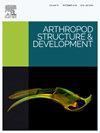Form-function relationships of the compound eyes and sensory sensilla of a tiny arboreal hemipteran herbivore: Adaptations for close encounters with leaves
IF 1.3
3区 农林科学
Q2 ENTOMOLOGY
引用次数: 0
Abstract
Herbivorous insects experience diverse plant stimuli, the relative influence of which depends upon the scale of the interface between both organisms and the insect’s life history. Using microCT and SEM, we conducted a whole insect study of the sensory structures of Glycaspis brimblecombei (Hemiptera: Psylloidea; commonly called psyllids or jumping plant lice) to understand this tiny insect’s utilisation of the leaves of their tree hosts – especially to reconcile rapid host assessment versus protracted, sinuous searching behaviours. Each compound eye comprises 360 ommatidia of relatively uniform density and facet diameter indicating limited spatial resolution and sensitivity. The areas of highest relative sampling resolution are not directed ventrally towards the surface of leaves but laterally and dorsally. There is a high abundance of chemo- and mechanosensory sensilla on the genal cones (216–240) and fewer on the terminalia (120–150), i.e. body parts regularly in contact with leaf surfaces. There are even fewer such sensilla on the basitarsi (10–16) and only putative olfactory sensilla on the antennae. Leaf surface conformation probably guides females to veins while contact chemoreception likely stimulates probing; the number of eggs deposited is likely determined by the flow and quality of nutrients experienced during feeding. For this psyllid, vision aids movements among leaves and relocation of hosts if dislodged by wind or escaping predators. Walking, as opposed to flying, maintains continuity of exposure to plant stimuli essential to maximising reproductive success. Such a life history is possible on large, evergreen hosts and is facilitated by rapid accept/reject discrimination of ingesta.
一种小型树栖半足类食草动物复眼和感觉器官的形式-功能关系:与树叶近距离接触的适应性。
草食昆虫经历多种植物刺激,其相对影响取决于生物和昆虫生活史之间界面的规模。利用微ct和扫描电子显微镜(SEM),对甘菊(Glycaspis brimblecombei)的感觉结构进行了全虫研究(半翅目:木科;通常被称为木虱或跳跃的植物虱子),以了解这种微小的昆虫对其树宿主叶子的利用-特别是协调快速的宿主评估与漫长的,曲折的搜索行为。每个复眼包括360个相对均匀的密度和面直径的小眼,表明有限的空间分辨率和灵敏度。相对采样分辨率最高的区域不是朝向叶片表面的腹侧,而是朝向叶片侧面和背面的区域。在一般球果(216-240)上有大量的化学和机械感觉感受器,而在顶部(120-150)上较少,即经常与叶表面接触的身体部位。basitarsi(10-16)上这样的感受器甚至更少,只有触角上假定的嗅觉感受器。叶片表面的构象可能引导雌性到静脉,而接触化学接受可能刺激探测;产卵的数量很可能是由饲养过程中所经历的营养物质的流动和质量决定的。对于木虱来说,如果被风吹走或逃离捕食者,视力有助于在树叶间移动和重新安置寄主。与飞行相比,行走可以保持植物刺激的连续性,这对最大限度地提高繁殖成功率至关重要。这样的生活史在大型常绿寄主上是可能的,并且通过对摄食物的快速接受/拒绝辨别来促进。
本文章由计算机程序翻译,如有差异,请以英文原文为准。
求助全文
约1分钟内获得全文
求助全文
来源期刊
CiteScore
3.50
自引率
10.00%
发文量
54
审稿时长
60 days
期刊介绍:
Arthropod Structure & Development is a Journal of Arthropod Structural Biology, Development, and Functional Morphology; it considers manuscripts that deal with micro- and neuroanatomy, development, biomechanics, organogenesis in particular under comparative and evolutionary aspects but not merely taxonomic papers. The aim of the journal is to publish papers in the areas of functional and comparative anatomy and development, with an emphasis on the role of cellular organization in organ function. The journal will also publish papers on organogenisis, embryonic and postembryonic development, and organ or tissue regeneration and repair. Manuscripts dealing with comparative and evolutionary aspects of microanatomy and development are encouraged.

 求助内容:
求助内容: 应助结果提醒方式:
应助结果提醒方式:


